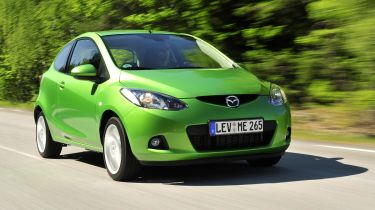Mazda 2
Weight-loss programme for striking new three-door creates the most efficient car in Mazda's line-up.

Mazda’s first three-door since 1996 is a success. It’s great to look at and, following a successful weight-loss plan, the 2 delivers real driving thrills with good fuel returns. Bearing in mind the Mazda’s generous standard kit and competitive pricing, Ford’s Fiesta – which shares 60 per cent of the 2’s underpinnings – has its work cut out. It will have to be even more stylish and a sensation to drive when it arrives in November.
It’s Mazda’s first three-door car for more than 10 years – so has this version of its 2 supermini been worth the wait?
Well, one thing is for sure – it certainly has a strong base to build on. When the five-door model arrived last year, it received a great reception, boasting lots of standard equipment and a five-star Euro NCAP score, all wrapped up in a sleek package that weighed 100kg less than its predecessor.
A similar diet programme has been applied to the three-door, shaving a further 10kg off its kerbweight, while the reprofiled front bumper improves the aerodynamics, reducing emissions. On the outside, the lack of rear doors further enhances the newcomer’s good looks.
To assist entry to the back seats, the doors have been extended by 220mm, and open wider than before. And the front passenger’s chair tilts and slides forward, creating easy access even for tall adults.
Used - available now
Shoulder room is ample in the back, but occupants over six feet are likely to struggle for headroom, despite the recess provided in the rooflining. Legroom is compromised for tall occupants, too. Thanks to the cushioned seats, though, short journeys are reasonably comfortable. In the front, the interior remains fresh and well thought-out. There’s an auxiliary input for MP3 players, handily positioned next to an Apple iPod-size storage space.
Plenty of cupholders have been fitted, and the glovebox has a handy slot for holding magazines or maps, which is simple but effective.
The engine line-up is shared with that of the five-door car. We drove the 67bhp 1.4-litre common-rail turbodiesel, which emits 114g/km of CO2, making this the most efficient car Mazda makes. On start-up, there’s no disguising that it’s an oil-burner, but the clatter settles down once up to temperature.
Only a five-speed manual box is available, although it has lengthened ratios which help to improve engine efficiency. The generous torque copes well with the gearing, so the 1.4 diesel is quicker off the mark than the 1.5-litre petrol variant. With its positive, accurate steering and fluid gearshift, the newcomer is very easy to drive as well.
Due to the decent visibility, gaps in traffic can be exploited, while the small turning circle makes light work of parking the car in tight spaces.
The baby Mazda is also really satisfying on the open road, again thanks in part to the strict weight-watching regime. It resists understeer in bends and, while the ride is fairly firm, it’s not at the expense of comfort, as body roll is equally well suppressed.
There are three trim levels, again mirroring what is on offer with the five-door. Prices start at £7,999 for the 74bhp 1.3-litre petrol TS, while the 1.4 diesel TS is £8,999. At £11,399, the 102bhp 1.5 Sport is the flagship model.
Highly attractive to look at and to drive, and with a light weight and frugal engine line-up, the three-door is a superb addition to the 2 range.
Rival: Honda Jazz
One of the best small cars ever, the versatile Jazz beats the 2 on practicality – but its age is starting to show. The Mazda is more stylish, better to drive, cheaper, and comes with a wider range of engines.











